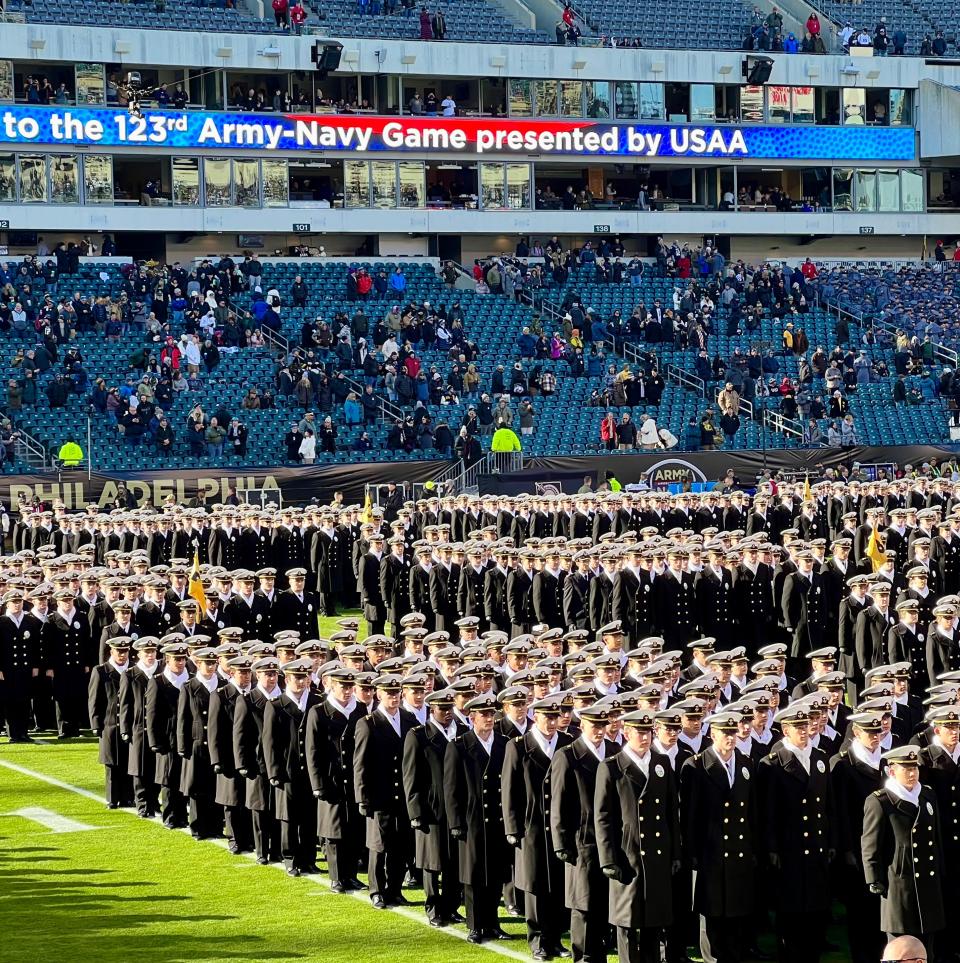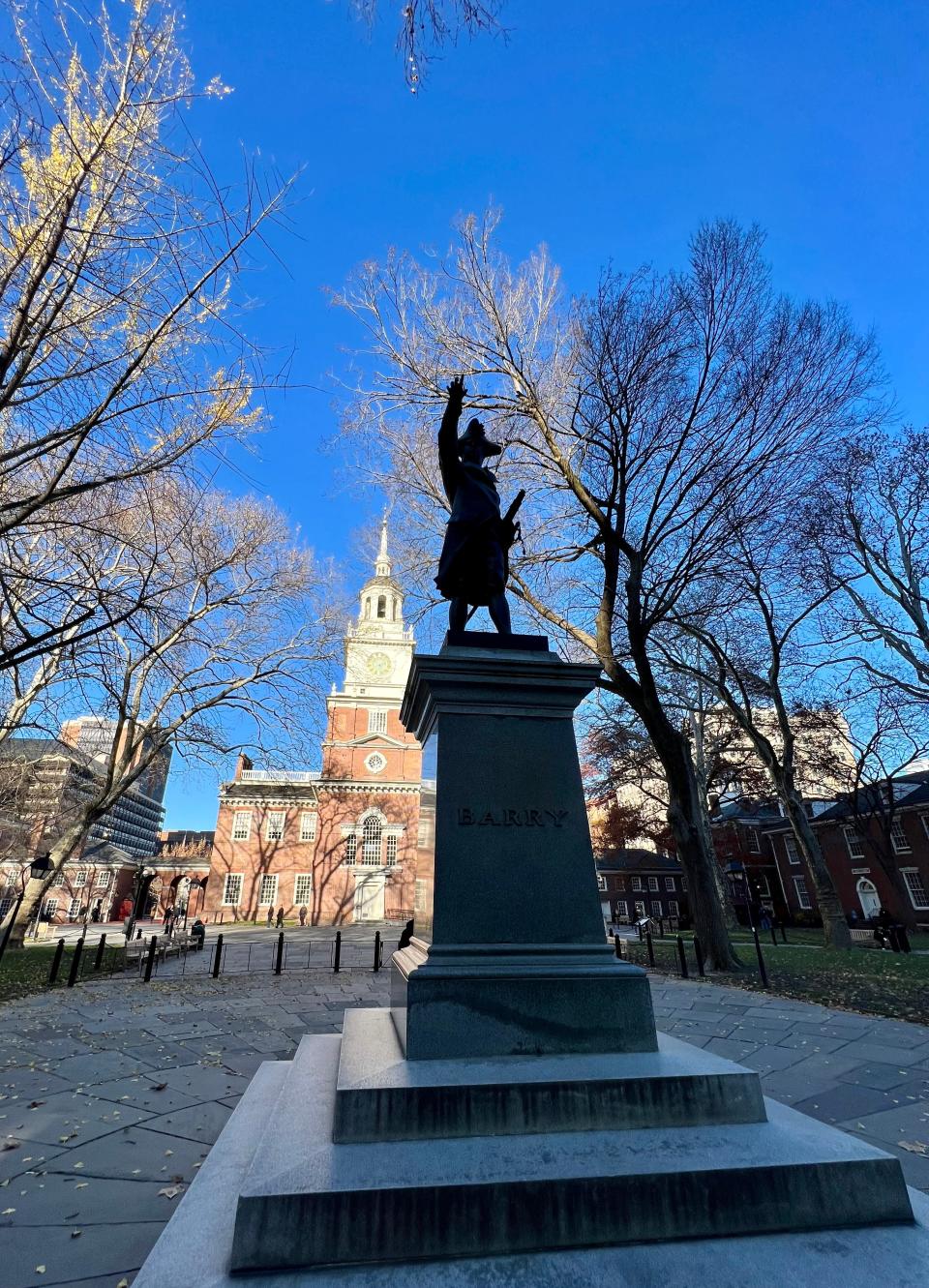Mark Woods: When Army and Navy meet in Philly, it's a rivalry to love
PHILADELPHIA — In a couple of decades as a sportswriter, I was fortunate enough to cover pretty much every major event (and quite a few minor ones that, in hindsight, I should have appreciated more).
I’ve been to all kinds of rivalry games — from Florida-Georgia football to Kentucky-Louisville basketball to Cubs-Cardinals baseball (the latter being particularly memorable because I sat in the stands between my dad, a Cubs fan, and his dad, a Cardinals fan).

But until Saturday, I’d never been to an Army-Navy football game.
I’d watched games on TV and read John Feinstein — author of “A Civil War: Army vs. Navy” — describe it as being America’s best rivalry, an annual sporting event that affects him unlike any other, starting with the pregame entrances and ending with the postgame singing of alma maters.
“It doesn’t matter who wins the game; when they play the alma maters, I cry,” Feinstein wrote in a 2018 Washington Post column.
So when Ron Elinoff ended up with a couple of extra tickets for this year’s game and asked if and Toni and I would like to join him and his wife, Susan, we jumped at the opportunity.
Elinoff, a retired dentist, grew up in Brooklyn but — in a familiar story for this area — came to Jacksonville with the Navy and ended up making it home. He’d already been to several Army-Navy games and was looking forward to the 123th meeting being played at Lincoln Financial Field in Philadelphia.
He tried to explain what makes this game different. He said that some of it is the traditions, the pageantry, the cadets and midshipmen — and some of it is how you have two groups of rival fans, intensely passionate about rooting for their team, but also realizing there are bigger things than the game.
You might see a fight break out in the stands at some other big rivalry game — or even a preseason NFL game (see the video of a fight at Jags preseason game that went viral) — but you won’t see that at Army-Navy. While you’ll hear and see playful banter, you’ll also see and hear mutual respect.
“It’s one of those things that’s hard to convey to someone,” he said. “You just need to be there to experience it.”
He said it makes you feel good.
He was right about that.
And it wasn’t just the game. It was the trip to Philadelphia.
The most frequent host of the Army-Navy game — 90 meetings have been held here — is a fitting site, and not just because it’s located roughly halfway between West Point and Annapolis.
Sunny in Philadelphia
Toni and I flew to Philly a day early and did some tourist things.
We started the day by taking the train to the city center, walking along the tree-lined Ben Franklin Parkway, passing a series of statues, eventually reaching what has become the city’s most popular one: Rocky.
We waited in line to take our picture next to Rocky, then climbed the stars, again doing the obligatory arm raise. All around us, others were doing the same.
On the way back to the Liberty Bell, one the day before the game that Feinstein described as “a civil war,” we walked past a monument tied to the Civil War. On its base, it said: “All who have labored today in behalf of the Union have wrought for the best interests of the country and the world, not only for the present but for all future ages.”
There was another statue nearby with an inscription that stuck with me. It’s of Francisco de Miranda, a Venezuelan leader who first served with the French during the American Revolutionary War. On one side is a Miranda quote: “There is in the world only one … nation in which you can discuss politics outside of the tried heart of a friend. That country is the United States.”
I’m not sure if this was completely true — if we ever were the only nation where this is true, or how true it is today — but it felt like a reminder that as ugly as our political debates can be, there is some beauty simply in the freedom to have them.

We waited in a long line to see the Liberty Bell. And even though I’d visited Independence National Historical Park before, once inside I learned details that I either wasn’t taught in school or had forgotten. (For instance, it wasn’t called the Liberty Bell before abolitionists seeking to end slavery in America were inspired by the bell’s inscription — a Bible verse about the Israelites freeing slaves — and referred to it in 1835 by the name we all use today.)
We stopped at another statue standing behind Independence Hall. On the front side, it simply says: BARRY.
On the back it says: Commodore John Barry U.S.N., Father of the Navy of the United States. Born in Wexford, Ireland, 1745. Died in Philadelphia, 1803.

From there, we meandered a few blocks to Mac’s Tavern. Mac’s is partly owned by Rob McElhenney, a Philadelphia native who created and stars in “It’s Always Sunny in Philadelphia” and, more recently, bought a lower-tier Welsh soccer team, Wrexham FC, along with Ryan Reynolds.
On this day, it was sunny in Philadelphia. And inside Mac’s there was a Wrexham FC (est. 1864) crest on the wall, Argentina vs. Netherlands on every television and Army and Navy fans in most of the seats. One bartender frantically tried to keep up. She occasionally took a poll, yelling for everyone for Army to raise their hands, then everybody for Navy — adding that nobody better say they were for Space Force.
When the World Cup match ended, she cued up fight songs, first Army, then Navy.
I noticed that after each song, fans of both teams applauded.
Living up to 'City of Brotherly Love'
A few days before the game, Ron asked if I knew who I’d be rooting for.
“Navy,” I said.
I never served, but I live in a Navy town, have quite a few Navy friends, and during the Iraq War had a memorable Navy embed in the Middle East. (As I’ve written before, the closest thing I’ve had to a war injury was getting pink eye while on a ship somewhere in the Persian Gulf.)
Plus, I knew Ron’s seats would be in the Navy section. So … Beat Army!
We arrived 3 ½ hours before kickoff. Ron explained that we didn’t want to miss any of the pregame — starting with the “March On” of the cadets and midshipmen, followed by the Navy Leap Frogs and Army Golden Knights appearing high above the stadium and parachuting onto midfield, the exchange of “prisoners” (the handful of cadets who spent a semester at the Naval Academy and midshipmen who spent a semester at West Point being returned to their classmates), the flyovers of Army helicopters and Navy jets, and the national anthem that began with what Feinstein described as “the snapping of 8,000 hands to salute position.”
By the time all this meticulously orchestrated pregame erupted into a joyful celebration for the start of the game, Toni and I already were saying it was indeed unlike any other sporting event.
When the game kicked off, the Navy players wore helmets that said “NASA” to pay tribute to the 54 Naval Academy graduates who have become astronauts. The Army players wore tank-inspired uniforms to honor the “Iron Soldiers” of the 1st Armored Division and the 80th anniversary of Operation Torch, the Allied invasion of North Africa during World War II.
Also joining the Elinoffs for the game was John Shoemaker. Ron, a huge baseball fan (particularly the Dodgers), became friends with “Shoe” when he led the Jacksonville Suns to a couple of Southern League titles in the early 2000s.
So it was interesting not only to get Shoemaker’s perspective on baseball past and present, but to hear his thoughts about his first Army-Navy game. He has spent his life at sporting events. But this one was on his bucket list. He traveled from his offseason home of Vero Beach to be there for it. And even before it went to overtime — a first in the history of the rivalry — he was saying it didn’t disappoint, how it was one thing to watch it on television, another to be in the stands.
The game itself was a low-scoring, defensive battle. To put it in baseball terms, it was a bit like a pitchers’ duel. Without any actual throwing.
I said I was rooting for Navy. When I noticed that at halftime both teams had zero passing yards — a stat I’d never seen in any football game — I started rooting for Navy and for both teams to finish with zero passing yards. For a while, it looked like that might happen. In the fourth quarter, Army spoiled it by completing the first pass of the game.
While Philly is legendary for crowds that are capable of turning on the home team and pelting Santa with snowballs, this was a very different vibe throughout the game. I mean, someone did come dressed as Santa. And when he appeared on the video screen, fans cheered — although not nearly as much as they cheered when cadets and midshipmen yelled, danced and posed for the cameras.
The game went to overtime, tied at 10-10. We were seated six rows from the end zone painted with “NAVY.” We assumed the extra time would be played near the other end zones, because that’s where cadets and midshipmen were seated.
So we were pleasantly surprised to see the teams line up at the 25-yard line in front of us. That’s when the low-scoring game changed. On the first play, Army’s Markel Johnson ran 25 yards for a touchdown. On the next play Navy quarterback Xavier Arline threw a pass — his only of the game — to a wide open Maqel Haywood for a touchdown.
In the next overtime, Navy fullback Anton Hall Jr. — whose 77-yard run was the only offensive touchdown in regulation — fumbled the ball on the goalline.
Army recovered, then kicked a field goal, winning 20-17, triggering a wild celebration, with cadets pouring out of the stands and onto the field and Hall falling to the ground, covering his face with his hands.
That scene alone was memorable.
Then it stopped abruptly, which was even more memorable.
The Army team and fans paused their celebration and stood quietly, reverently for the playing of “Navy Blue and Gold.” Some stories said many Navy players were in tears. So were, I’m sure, some fans. And not necessarily because of the result.
As the winning team, Army had the honors of finishing off the night this year, singing the West Point alma mater.
The game had an announced attendance of 69,117. And even at the end, on a chilly December evening in Philly, most were still there.
After the game, as traffic squeezed out of the parking lots, Ron noted how even this was different. Drivers were taking turns, allowing others to merge into the flow.
mwoods@jacksonville.com
(904) 359-4212
This article originally appeared on Florida Times-Union: Army-Navy football game more than lives up to billing

